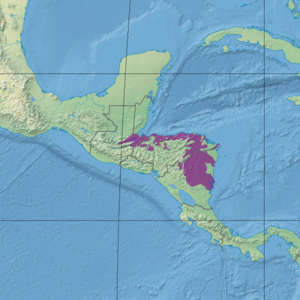| Central American Atlantic moist forests | |
|---|---|
 Cerro Chachahuate | |
 Ecoregion territory (in purple) | |
| Ecology | |
| Realm | Neotropical |
| Biome | Tropical and subtropical moist broadleaf forests |
| Borders | |
| Geography | |
| Area | 89,979 km2 (34,741 sq mi) |
| Countries | |
| Coordinates | 13°45′N 84°45′W / 13.75°N 84.75°W |
| Conservation | |
| Protected | 30.2%[1] |
The Central American Atlantic moist forests ecoregion (WWF ID: NT0111) covers the lowland coastal forests of Honduras, southeast Guatemala, and the eastern forests of Nicaragua (plus two small patches in Belize). Half of the ecoregion is closed-canopy tropical broadleaf evergreen forest, with tree heights reaching 50 meters.[2][3][1] This ecoregion has the largest single fragment of natural forest in Central America, with a size of 14,629 square kilometres (5,648 sq mi).[4] The total area is 89,979 square kilometres (34,741 sq mi).
Location and description
[edit]The ecoregion stretches for 700 km from the valley of Lake Izabal in southeastern Guatemala, across the northern coast of Honduras (in a 50 km wide strip), and down across most of the eastern half of Nicaragua (additionally alongside two minuscule patches in Belize). The mean elevation is 293 metres (961 ft), with a maximum of 2,270 metres (7,450 ft).
Climate
[edit]The climate of the ecoregion is Tropical monsoon climate (Köppen climate classification (Am)). This climate is characterized by relatively even temperatures throughout the year (all months being greater than 18 °C (64 °F) average temperature), and a pronounced dry season. The driest month has less than 60 mm of precipitation, but more than (100-(average/25) mm. This climate is mid-way between a tropical rainforest and a tropical savanna.[5][6] Average precipitation in the ecoregion is 2,333 mm/year.[4]
Flora and fauna
[edit]Half of the ecoregion is closed-canopy broadleaf evergreen rain forest, but with 30% of the territory converted agriculture. The remainder is open canopy evergreen forest or herbaceous wetland.[1] From 1990 to 2000, the ecoregion was experiencing deforestation at a rate of just under 1% per year. The ecoregion contains a number of large undisturbed fragments, which is important for larger species of animals. (The largest mammals require an estimated 100 km2 fragment to sustain viable populations).[4]
Protected areas
[edit]30.2% of the ecoregion is officially protected.[1] These protected areas include:
- Agalta National Park
- Azul Meámbar National Park
- Blanca Jeannette Kawas National Park (Punta Sal)
- Bosawás Biosphere Reserve
- Capiro-Calentura National Park
- Cerro Azul National Park
- Cerro Saslaya National Park
- Chocón Machacas
- Cuevas de Silvino National Park
- Cusuco National Park
- Montaña de Botaderos Carlos Escaleras Mejía National Park
- Montaña de Yoro National Park
- Nombre de Dios National Park
- Omoa National Park
- Patuca National Park
- Pico Bonito National Park
- Pico Píjol National Park
- Punta Izopo National Park
- Port Royal National Park
- Río Dulce National Park
- Río Plátano Biosphere Reserve
- Santa Bárbara National Park
- Tawahka Asagni Biosphere Reserve
- Temash-Sarstoon National Park
References
[edit]- ^ a b c d "Central American Atlantic moist forests". Digital Observatory for Protected Areas. Retrieved 29 March 2022.
- ^ "Central American Atlantic moist forests". World Wildlife Federation. Retrieved March 21, 2020.
- ^ "Map of Ecoregions 2017". Resolve, using WWF data. Retrieved September 14, 2019.
- ^ a b c "An overview of forest biomes and ecoregions of Central America" (pdf). Routledge. Retrieved October 9, 2020.
- ^ Markus, Kottek; Grieser, Jürgen; Beck, Christoph; Rudolf, Bruno; Franz, Rubel (June 2006). "World Map of Koppen-Geiger Climate Classification Updated" (PDF). Gebrüder Borntraeger 2006. pp. 259–263. Retrieved September 14, 2019.
- ^ "Dataset - Koppen climate classifications". World Bank. Retrieved September 14, 2019.